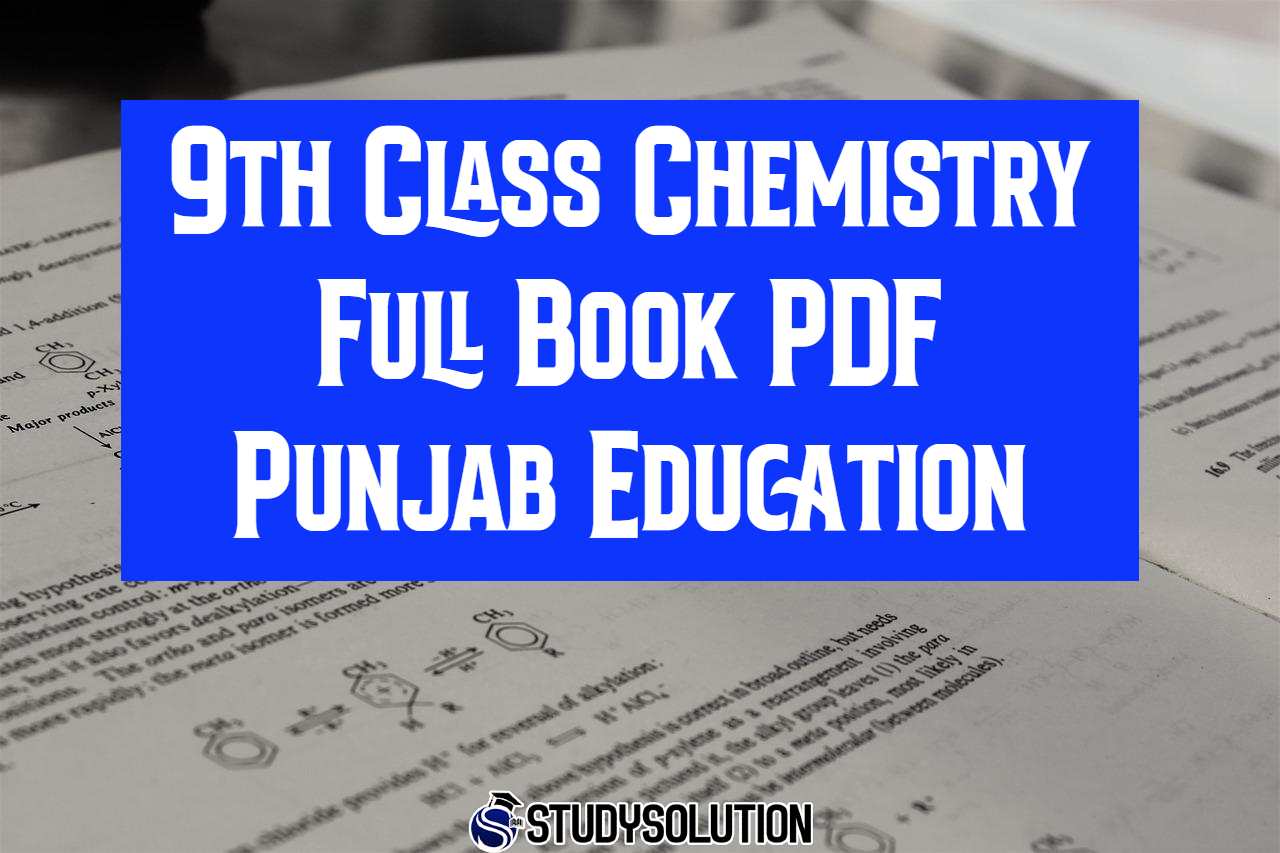9th Class Chemistry Full Book PDF Punjab Education – Get English And Urdu Medium
9th Class Chemistry Full Book PDF Punjab Education the Punjab Textbook Board’s Chemistry text for the ninth level is written with first-time students in mind. It merely covers the material necessary to get students started in chemistry. In contrast to other books, this one will not concentrate on a particular idea but instead will cover all of the various subfields that fall under the umbrella of chemistry.
The government of Punjab has made changes to the book and its arrangement to be easier to read; it is now a vibrant book covering a wide range of exciting subjects. In addition to that, they have released this book along with discussions about each lesson on eLearn Punjab. What more could you possibly want? In addition to this, you can quickly locate previous papers and paper designs to comprehend the examination requirements better.
What exactly does the book cover?
This book is broken up into eight sections, and all of the sections are connected. You will need to study all of the chapters to do well on the chemistry exam based on the Punjab Textbook. Although we have a pairing system for scientific topics, this is only for practice.
Why is it considered to be the most excellent textbook for chemistry?
You can consider the chemistry Punjab textbook board an excellent textbook for newcomers to the field of chemistry for the reasons detailed below.
- An outline can be found at the beginning of each chapter, and its purpose is to ensure that students and teachers are on the same page regarding the unit’s content.
- There is an extensive list of descriptions of each topic, which may be found next to the issues themselves. It has the potential to pique the interest of the students.
- The exercises have been developed following the format of the paper.
- Every idea is presented and discussed in sufficient detail.
Each chapter is essential in its particular field. The following is a synopsis of each chapter in its entirety.
1. The building blocks of chemical knowledge
The fundamental ideas of chemistry are covered in detail in this chapter. There is a connection between chemistry and the transdisciplinary sciences. The basic concepts of chemistry are the primary focal point of this chapter.
- The masses of molecules and atoms, respectively.
- Avogadro’s number
- Calculations in the field of chemistry.
2. The architecture of atomic particles
It will be challenging to comprehend the processes involved in chemical reactions if one is not familiar with the structure of atoms. Therefore, the second chapter is essential for grasping the fundamentals of chemistry.
One should think about this chapter to comprehend the structure of atoms as well as their significance in the process of calculating chemicals. The following are some topics that will be used often throughout this chapter.
- Theories concerning the components of atoms.
- The investigation led to the discovery of the atom and its parts.
- The idea behind how the electrical properties of each constituent are configured.
3. The periodic table of elements and the periodicity of property
The periodic table is the foundation upon which the science of chemistry is built. This chapter discusses the origins of the periodic table, including its design and construction and its relevance to the table. The following are some of the ideas that the students will get to study about in this chapter.
- The tendencies of several different atomic characteristics.
- A look back at the development of the periodic table.
4. The make-up of the molecule’s structure
This chapter is vitally important for understanding the principles of chemical bonding. The following ideas are broken down in further detail throughout this chapter.
- Putting together chemicals
- The creation of substances and combined elements.
5. The many physical states of matter
It is vital to have a solid understanding of the atomic composition of all substances and the constitution of matter, which is covered in this chapter. The following are some of the ideas that are covered in this section.
- The characteristics and rules govern the gaseous state of matter.
- The rules and characteristics of the states of matter are known as liquid and solid.
6. The study of electrochemistry
The principles of applied chemistry are discussed in the book’s concluding chapter. This is a lengthy chapter with the same significance level as the others. The following ideas are broken down in further detail throughout this chapter.
- The cells are involved in electrochemistry.
- Oxidation and reduction reactions are taking place.
- The application of chemical cells in industrial settings.
7. The reactivity of chemicals
This chapter discusses the reactivity of metals and non-metals, a topic that, despite its apparent simplicity, is of the utmost significance.
How to do well in the ninth-grade chemistry exam given by the Punjab Board
You must adhere to the following guidelines to succeed in chemistry PTBB for the 9th grade. The following are some recommended tips and tactics to get high scores.
Attend every single one of the seminars.
Skipping even one class during the transition to a new scientific subfield can throw off your understanding of the material. If you have missed any of the classes, you must stay in contact with your instructor and ask them questions.
The ideas should be underlined and emphasized.
The book has many definitions; all you need to do is underline all of the key ideas as you go through them. You should keep a highlighter or a pencil with you and mark the words that you find particularly challenging.
Revision
There are two different approaches to updating the notions. When you have done going over the material with the class, you should first go back and reread the chapters. You shouldn’t rush through it; you should try to complete no more than one chapter every single month. In addition, the first round of changes should be done slowly and should include all of the information that was omitted. During your review, you should make an effort to consult the internet and several guides.
Solving previous exams is another method of review that may be done. The Punjab textbook board has been using the same time-honored format to evaluate the pupils in the ninth grade for the past decade. As a result, you will be able to effectively manage time and accurately predict the amount of time required to solve a whole paper.
Find the answers to all of the questions.
Those looking for already prepared questions will find great value in the exercises. Examine the questions asked in the papers with those from the activities. Try to find answers to all of the questions; completing even a few questions each day helps speed up the process.
Make an effort to solve the numerical problem.
In chemistry, numerical considerations are frequently disregarded. However, chemical computations are of equal significance. It would be best to begin by thinking about the provided examples and then solve the numerical problems accordingly. You might also look at some guides to help you tackle the numerical problems.
Make multiple-choice questions
Questions based on a multiple-choice format may be asked about the brief sentences followed by explanations. Create your inquiries in this regard. Do not undervalue the significance of the ponderable topic and the tidbits.
Make diagrams
You need to demonstrate to the examiner that you comprehend the material very well if you want to succeed academically. Without creating structures and diagrams, it is hard to get good grades in chemistry. Create them wherever and whenever it is required.
How can one comprehend the chemistry idea covered in the ninth grade?
Because atoms and molecular structures are unseen and we cannot sense them, it can be pretty challenging to understand the concepts involved in chemistry. The advice that follows can be of great assistance.
1. Make atomic structures
Try your hand at building the structure of whatever you are learning about, be it a new atom or molecule. The formation of ions and the evacuation of electrons can be visualized with these drawings’ help.
2. Create flowcharts and diagrams.
You might find that drawing flowchart diagrams help you comprehend concepts such as laws and theories. After each round of revision, practice these diagrams; doing so will assist you in remembering the idea.
3. Experiment with the chemicals you have at home.
Compounds are everywhere around us, and if we want to understand the fundamentals of chemistry better, we may always experiment with these chemicals. For instance, if you’re going to understand the appearance of crystalline solids, you may look at NaCl (Table slat), and if you want to understand soda, you can look at baking powder or detergents.
4. Pay the Laboratory a regular visit.
Request your instructor that you be taken to the laboratory to investigate different chemicals and compounds and the apparatus used to carry out chemical reactions.
5. Imagine A lot
Even though we cannot see an atom with the naked eye, we can better understand its structure by looking at diagrams and photographs of atoms. Putting your mind to the task of envisioning it will help you learn.
6. View some videos online.
In this age of the internet, you can examine the development of new compounds through some fantastic graphical representation. It is only a couple of mouse clicks away. It is a better use of your time to watch these films than to squander time aimlessly browsing the internet.
7. Engage in conversation with your instructor.
Your instructor is your savior; you have no one else save your instructor on whom you may rely for help. Make sure you take notes and ask as many questions as you like of your teachers.
Complete Book of Chemistry for Class 9th in English Medium Available Online View:
Stay With Us For Latest Updates




